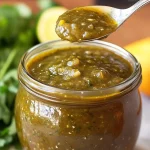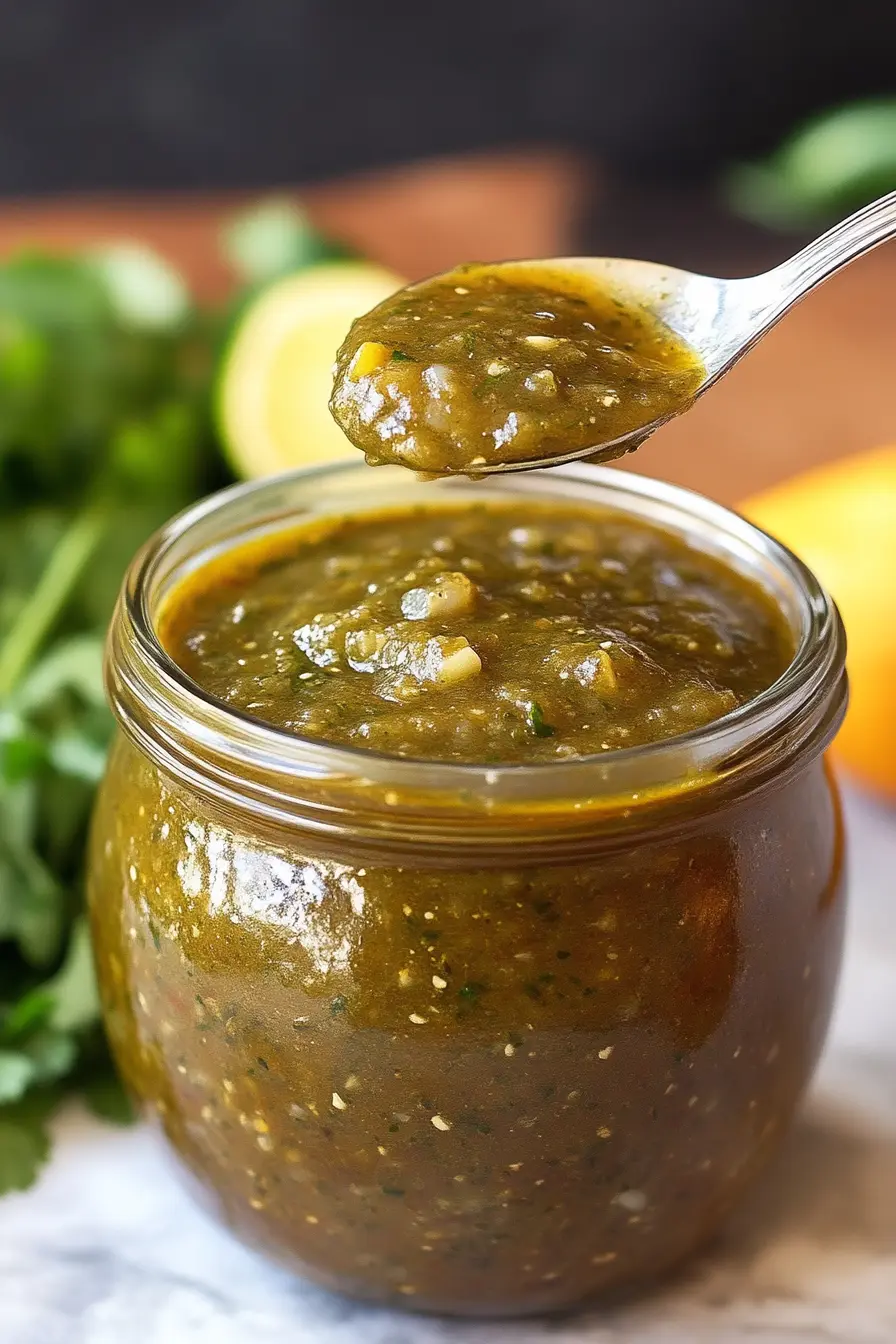Green enchilada sauce adds a fresh, zesty kick to all kinds of Mexican-inspired meals, and I whip it up whenever I need something homemade that beats the store-bought jars. This version uses roasted tomatillos and peppers for that vibrant color and mild spice, and it takes about 45 minutes from start to finish. I love how easy it is to adjust the heat or swap in veggie broth for a plant-based twist.
In this post, I’ll share the full list of what you need, the step-by-step process I follow in my kitchen, plus ways to store it, reheat without losing that brightness, and ideas for using it beyond just enchiladas. Whether you’re new to making sauces or just want a reliable recipe, stick around, I’ll cover everything, including fixes for common issues like a too-thick blend or uneven roasting.
If you’re in a rush, the key is roasting the veggies first to build flavor, then blending and simmering briefly. You can scale it down for a small batch or double it for freezing. Let’s get into the details.
Equipment
- Rimmed baking sheet
- Parchment paper or foil
- Sharp knife
- Cutting board
- Blender or immersion blender
- Medium pot
- Wooden spoon or spatula
- Measuring cups and spoons
Recipe Ingredients
- 1 1/2 pounds tomatillos, husks removed and rinsed well
- 1 jalapeño pepper, seeded and stem cut off
- 4 poblano peppers (or Anaheim peppers), seeded and stems removed
- 1 small onion, cut in half
- 4 garlic cloves, peeled
- 1 bunch fresh cilantro (stems and leaves)
- 1 teaspoon ground cumin
- 1 teaspoon Mexican oregano (or regular oregano)
- 1 teaspoon chicken bouillon powder (use vegetable for a vegan option)
- 1 teaspoon salt
- 3 cups chicken broth (or vegetable broth)
- 1 tablespoon fresh lime juice
How To Make Green Enchilada Sauce
- Heat your oven to 425°F. Cover a baking sheet with parchment or foil to catch any drips—makes cleanup a breeze.
- Place the tomatillos, jalapeño, poblanos (or Anaheims), onion halves, and garlic on the sheet in one layer. No need for oil unless you want a bit more char; I usually skip it to keep things light.
- Slide the sheet into the oven and roast for 20-25 minutes. Flip everything halfway to get even browning. The peppers should blister, tomatillos soften and maybe split a little, and the garlic should smell amazing without burning.
- Pull the tray out and let the veggies cool just enough to handle. Toss them into your blender along with the cilantro bunch (no need to chop), cumin, oregano, bouillon, and salt. Add about 1 cup of the broth to get things moving.
- Blend on high until it’s smooth and green—no chunks left. If it sticks, stop and scrape the sides with a spatula. This takes 1-2 minutes tops.
- Pour the pureed mix into a medium pot. Stir in the remaining 2 cups of broth. Set the heat to medium and bring it to a simmer—don’t let it boil hard.
- Once it’s bubbling gently, lower the heat and let it cook for 15 minutes. Stir every few minutes so it doesn’t stick. The sauce will reduce a bit and get that nice coating texture.
- Squeeze in the lime juice right at the end and give it a good stir. Taste it—add a little more salt if your broth was mild, or another drop of lime for brightness.
- Take it off the heat and let it sit for 5 minutes. It’ll thicken up as it cools. That’s it—your green enchilada sauce is ready to use.
This method draws from traditional salsa verde techniques but keeps it simple for home cooks. Roasting mellows the raw sharpness of the tomatillos, which are key for that tart base, while the poblanos add earthiness without overwhelming heat. If you’ve never worked with tomatillos, they’re like green tomatoes but tangier—always rinse off the sticky husk residue under water.
Storage and Reheating Tips
Once cooled, spoon the sauce into airtight jars or containers. It stays good in the fridge for up to 7 days; the lime helps preserve that fresh taste. For freezing, portion it into 1- or 2-cup amounts in freezer bags—flatten them out so they stack easily and thaw fast. It holds up in the freezer for 3 months without losing much vibrancy.
When reheating, go low and slow: Pour it into a pot over medium-low heat and stir until it’s warm and steaming, about 5 minutes. If it’s from the freezer, defrost in the fridge overnight first to avoid watery separation. A quick microwave works in a pinch—30-second bursts with stirring—but stovetop keeps the flavors intact better. If it seems too thick after chilling, whisk in a tablespoon of broth or water until it’s pourable again.
How to Serve
I drizzle this over stacked enchiladas with cheese and onions, or use it to braise chicken thighs until tender. It works great as a base for chilaquiles—toss fried tortilla chips in a skillet with the sauce, top with eggs and crema. For a quick dip, thin it slightly and serve with veggies or chips. Last time, I mixed it into ground beef for tacos, and it cut through the richness just right. You can even spoon it over grilled fish or roasted potatoes for a non-Mexican twist.
Recipe Tips
- Rinse tomatillos thoroughly after peeling; that sticky sap can make the sauce taste off if left on.
- For milder sauce, remove all seeds from the jalapeño; leave a few for a subtle kick.
- If your blender struggles, work in batches to avoid overflow.
- Mexican oregano has a citrusy note—regular works fine, but hunt it down at a Latin market if you can.
- Taste the broth before adding; low-sodium versions might need extra salt.
- Don’t skip the cilantro—it’s what gives the sauce its signature herby punch.
- If the roasted veggies are super juicy, drain a bit before blending to control thickness.
Frequently Asked Questions
Can I use canned tomatillos instead of fresh?
A1: Sure, but fresh roasted ones give better flavor. If using canned, drain them well and skip the roasting—sauté the onion, garlic, and peppers first, then blend everything. Add 5 extra minutes to the simmer to build depth.
How do I make this spicier?
A2: Add another jalapeño or a serrano pepper during roasting. You could also stir in a pinch of cayenne after blending. Start small and taste as you go—it’s easier to add heat than take it away.
Is this sauce suitable for vegetarians?
A3: Yes, just swap the chicken bouillon and broth for vegetable versions. Everything else is plant-based, so it fits right into a meat-free diet without changes.

Green Enchilada Sauce
- Total Time: 10 minutes
- Yield: 1 cup 1x
- Diet: Gluten Free
Ingredients
- 1 1/2 pounds tomatillos, husks removed and rinsed well
- 1 jalapeño pepper, seeded and stem cut off
- 4 poblano peppers (or Anaheim peppers), seeded and stems removed
- 1 small onion, cut in half
- 4 garlic cloves, peeled
- 1 bunch fresh cilantro (stems and leaves)
- 1 teaspoon ground cumin
- 1 teaspoon Mexican oregano (or regular oregano)
- 1 teaspoon chicken bouillon powder (use vegetable for a vegan option)
- 1 teaspoon salt
- 3 cups chicken broth (or vegetable broth)
- 1 tablespoon fresh lime juice
Instructions
- Heat your oven to 425°F. Cover a baking sheet with parchment or foil to catch any drips—makes cleanup a breeze.
- Place the tomatillos, jalapeño, poblanos (or Anaheims), onion halves, and garlic on the sheet in one layer. No need for oil unless you want a bit more char; I usually skip it to keep things light.
- Slide the sheet into the oven and roast for 20-25 minutes. Flip everything halfway to get even browning. The peppers should blister, tomatillos soften and maybe split a little, and the garlic should smell amazing without burning.
- Pull the tray out and let the veggies cool just enough to handle. Toss them into your blender along with the cilantro bunch (no need to chop), cumin, oregano, bouillon, and salt. Add about 1 cup of the broth to get things moving.
- Blend on high until it’s smooth and green—no chunks left. If it sticks, stop and scrape the sides with a spatula. This takes 1-2 minutes tops.
- Pour the pureed mix into a medium pot. Stir in the remaining 2 cups of broth. Set the heat to medium and bring it to a simmer—don’t let it boil hard.
- Once it’s bubbling gently, lower the heat and let it cook for 15 minutes. Stir every few minutes so it doesn’t stick. The sauce will reduce a bit and get that nice coating texture.
- Squeeze in the lime juice right at the end and give it a good stir. Taste it—add a little more salt if your broth was mild, or another drop of lime for brightness.
- Take it off the heat and let it sit for 5 minutes. It’ll thicken up as it cools. That’s it—your green enchilada sauce is ready to use.
Notes
- Rinse tomatillos thoroughly after peeling; that sticky sap can make the sauce taste off if left on.
- For milder sauce, remove all seeds from the jalapeño; leave a few for a subtle kick.
- If your blender struggles, work in batches to avoid overflow.
- Mexican oregano has a citrusy note—regular works fine, but hunt it down at a Latin market if you can.
- Taste the broth before adding; low-sodium versions might need extra salt.
- Don’t skip the cilantro—it’s what gives the sauce its signature herby punch.
- If the roasted veggies are super juicy, drain a bit before blending to control thickness.
- Prep Time: 10 minutes
- Cook Time: 0 minutes
- Category: Sauce
- Method: Blending
- Cuisine: Mediterranean
Nutrition
- Serving Size: 2 tbsp
- Calories: 90 kcal
- Sugar: 0 g
- Sodium: 100 mg
- Fat: 9 g
- Saturated Fat: 1 g
- Unsaturated Fat: 8 g
- Trans Fat: 0 g
- Carbohydrates: 1 g
- Fiber: 0 g
- Protein: 0 g
- Cholesterol: 0 mg

